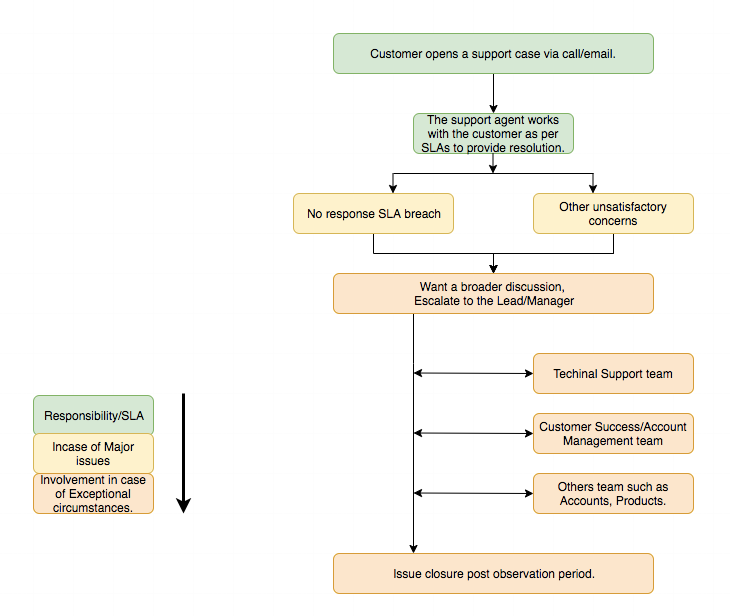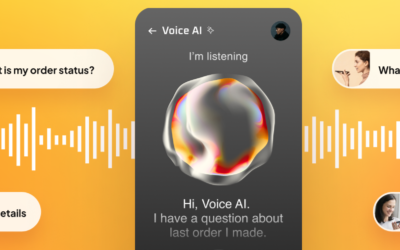
Olga Rotanenko, BizDev Director
28 april 2022
While companies try to provide the best possible service to every customer, it is not possible to please everybody. Once in a while, you will get dissatisfied customers, and your team needs to be trained on how to handle such inquiries. This is very important because negative customer experiences can have serious consequences for your business. In fact, roughly 50% of customers say they would switch to a new brand after one bad experience. In this article, we will talk about how to deescalate an angry customer and hopefully flip them from a dissatisfied client into a brand ambassador.
Customer Escalation – What is It?
Escalation is a mechanism that allows you to resolve an incident in time by improving and increasing the capabilities of employees. That is, for example, the first level of support determines that they cannot resolve the issue; the second level is connected, escalating the overall efforts for a solution. The image below depicts an example of one type of escalation plan:

A well-organized escalation plan has a time frame as well as levels of responsibility depending on the priority and complexity of the solution. The decision time is approved through negotiations with the served users, from which the SLA deadlines follow. The SLA plays an important role in the escalation process since it spells out the quality, availability, and timeliness of the services being provided. Let’s take a closer look at SLAs to understand how you can use them.
SLAs and Escalation
A Service Level Agreement (SLA) is an external document (existing between the customer and the contractor) that describes the parameters of the service provided. SLA Compliance is equivalent to the fact that the service works in such a way that the real parameters do not go beyond the metric ranges declared in the agreement. In addition to the boundaries, the SLA specifies the service parameters and their allowable fluctuations. These should be measurable parameters that the client and the service company itself can evaluate – a kind of KPI that the service must meet. This, by the way, is the difference between SLA and KPI. Although these concepts are often confused, KPIs are metrics in their own right, while SLAs are an agreement on what they should be.
For example, the agreement can state that the support specialist has the right to respond not immediately but within 4 hours after the registration of the application. He has the right not to answer on weekends and holidays.
Escalations monitor processes to make sure that everything in the SLA is being followed. When you create an escalation for a service level agreement, the escalation is applied to the business object (such as a service request or incident) that is used in the service level agreement. Each service level agreement has a one-to-one relationship with an escalation, and each commitment in a service level agreement maps to an escalation point in the corresponding escalation.
Defining an Escalation Situation In Your SLA
Usually, an escalation situation will occur when a level 1 support agent does not have an answer to a customer inquiry and will need to pass this question on to someone higher. Escalation systems can be broken down into two categories: functional and hierarchical. Both of these systems involve a customer who is getting frustrated by the amount of time it takes to get an answer or resolution to a particular issue.
Creating a Plan of Actions for Incident Situation
You need to have a plan for escalating a difficult situation that involves various de-escalation techniques for customer service and how such incidents will be handled. Your processes need to specify who should be notified when an incident is alerted, who should escalate the incident if the first responder is not available, who should take over the problem if the responder cannot resolve it on their own, and how the transfer should take place (via help desk? Direct from one technician to another? Through an incident management tool?).
At first glance, these questions seem simple, but the larger the organization and the more complex the technology ecosystem, the more detailed the answers should be. For example, the answer to the question of who should be notified when an incident is alerted may depend not only on who is on duty and available but also on the severity of the incident, its duration, etc.
Training consultants
You agents need to know the various de-escalation techniques for customer service. One of the main things to focus on is empathizing with your customers. When they call in with various issues, they want to know that the agent can place themselves in their issues and understand what they are experiencing. Believe it or not, this can deescalate a lot of difficult situations. This leads us to the next de-escalation technique is to simply let the customer talk. They want to vent out their frustration, and they aren’t necessarily thinking about the feelings of the agent on the other end. That’s why it is always important to remain calm and never take things personally. Be sure to give your agents the necessary customer service de-escalation training so they will be prepared to handle any scenario.
Timing is Everything
The reason that timing is important is that the customer is already angry and frustrated, and they are looking for a quick solution. This means that you should not put the customer on hold and make sure that it does not take them a long time to connect with an agent, be it through call, instant chat, and any other channel that you offer. Next, you should give them a realistic plan of action that will resolve the problem as quickly as possible. The representative should ensure the customer that the problem is fully understood. Then, explain that the support team would provide an action right away.
Drop the Defensive Attitude
When customers are venting their frustrations, it is easy for regents to get defensive and lash back out at the customers. Needless to say, this is not a great idea. Resist the urge to evade, defend, or accuse when customers are not satisfied. The goal is to resolve the customer’s issues and not inflict more frustration. You will regain customers’ trust when you take ownership of your mistakes, offer a sincere apology for the trouble, and fix the errors.
Preventive Actions
Now it is time to think about how you can resolve customer inquiries before there is a need for escalation. One of the most important things you can do is provide a seamless customer experience. If you saw a surge in complaints from customers about the ease and efficiency of your website or mobile platforms, it might be wise to step up your game this year.
Another thing you can do is open up new support channels. Give your customers methods of reaching you, thus making it even more convenient and easy to get their problems solved. If you’re already using social media, try to come up with new and creative ways this channel can be used to help increase the quality of your support. This can be something like posting polls to get feedback from your customers on how well you are doing.
Trust Pexly to Provide Your Customers With Excellent Experiences
It is important to have best practices for customer escalation management in place and be ready to resolve your customers’ problems fast and effectively. Not only can customer escalation best practices help you resolve a customer’s concern, but they can also create an opportunity to transform a dissatisfied customer into a lifetime subscriber. Pexly can help you implement the right escalation strategy and help you with every aspect of setting up your offshore team. Contact us today to learn more about how we can help you.



